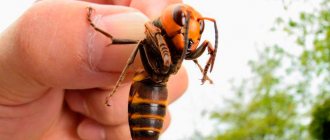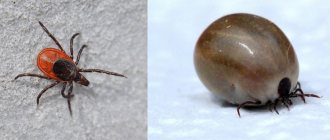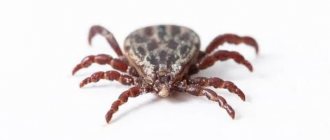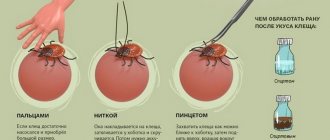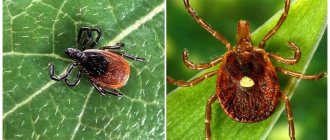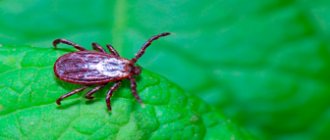Hello, dear readers! A few days ago, my husband returned from a hiking trip and told a scary story, which prompted me to write this post. My family and I live in the Rostov region and very often my husband goes with a camera “to get new shots.” Last year, in May, one of the trophies was a tick bite, which we survived with a certain amount of hysteria.
According to Rospotrebnadzor, by May 5, 2022, 31 thousand people sought medical help for tick bites - this is 1.8 times less than last year.
This time there have been no bites so far, but the prospect that arose on the last trip is, let’s say, promising. Throughout the entire hike, all he and his friend did was remove ticks from their clothes and shake off their boots. And at night, in the tent, they found a pair of bloodsuckers right under the sleeping bag. After reading a bunch of literature, I created a summary of the main points that you need to know if you or someone close to you is at risk and may be bitten by a tick.
Types of ticks. Which ticks are dangerous?
Today, science knows more than 48 thousand species of ticks. Can you imagine?! Most of them have not been studied and every year scientists discover new groups. We are interested in ixodes ticks (Ixodes), because... two representatives of this family pose a direct threat to humans - Ixodes persulcatus (taiga tick) and Ixodes ricinus (dog or European forest tick). So not all bloodsuckers are carriers of terrible infections, and if you find an unwanted guest on your body, you should not immediately faint. Moreover, even if the tick is infected, the probability of disease is not one hundred percent.
What ticks are found in Russia, Ukraine and Belarus
In our latitudes there are most taiga ticks, less black-legged ticks. Individuals of the dermacentor species (meadow and pasture mites) are also often found. In the southern regions you can find a couple of agras species.
In Russia, ticks are distributed almost throughout the entire territory, but infected individuals are found in the central, eastern and northern regions . Especially many cases of encephalitis infection are recorded in the Tomsk, Sverdlovsk, Kurgan and Tyumen regions, as well as in the Altai Mountains and Buryatia.
Habitat area of encephalitis ticks
As for Ukraine, infected ticks are more common in the central regions, less often in the western and eastern regions. Approximately the same picture is observed in Belarus.
Tick activity
I dug up a picture on the Internet that very well illustrates the period of tick activity by month:
The first ticks wake up at 6-8 degrees Celsius, and hibernate at the first frost. You need to know: tick activity is high both in spring and summer. As soon as the sun warms the earth and greenery appears, we immediately remember about ticks and turn on increased vigilance.
How long does it take for a tick to drink blood?
Many people are interested in the question: “How long does it take a tick to drink blood?” In answering this, it should be noted that the duration is significantly different for male and female individuals. We can say that males pose a great danger, since they become saturated with blood very quickly. A person may find a tick already crawling and think that the bite has not yet occurred.
The female, on the contrary, requires a long time to be completely saturated, usually several days. She is able to consume 100 times more blood than her body weight. Before breeding, they feed on food for 10 days. Therefore, it is easier to detect them during the absorption process.
The time required for complete saturation of the parasite also depends on the stage of development and the previous period of hunger. The nymph gets drunk much faster than the adult. If the ixodid tick has been starving for more than 4 months, then it will take much longer than usual to become completely saturated.
Thus, it is impossible to say unambiguously how long it will take the tick to become completely saturated. The process can last from two hours to 14 days. But in most cases, enough time passes to detect the parasite on the body.
What does a tick look like (photo)
The taiga tick lives in the Asian and several regions of the European part of our country. His brother in arms, Ixodes ricinus, is more likely to be encountered by those who, like our family, settled in the south of Russia. Here is a comparative photo of all varieties of this specimen:
Ixodes Ricinus .
Male, nymph, female and tick larva. I showed my husband the photo, he said that he more often removed males from his trousers than females. I was also surprised why some mites are black, while others have a reddish tint. All ticks of this species have a powerful shell and four pairs of legs. The reddish tint of the female is due to the fact that the integument of the back part is capable of greatly stretching and absorbing hundreds of times more blood than the weight of a hungry tick.
Here is such a cute female of the genus Ixodes
To our great happiness, we did not meet a female that had drunk blood, but I will also show you a photo. For comparison and greater ostracism. God forbid you encounter something like this:
Female ticks feed for 6 to 10 days. Now let's look at the male. It is smaller and not as bloodthirsty as its “weak” half - it sticks for a short time (less than an hour). Look carefully at these photos and remember what the male and female Ixodes ricinus look like. They don’t have eyes, but they have a very strong sense of smell: they can smell prey ten meters away.
By the way, if you were bitten by a male and you didn’t notice him right away, the situation may become more complicated. After drinking blood, the tick falls off and you are rewarded with a reddened spot on the skin, the origin of which you can only guess. If you do not find out in time the nature of this stain, you risk finding yourself in a dangerous situation.
Prevention of tick-borne encephalitis
Always take extra precautions when walking in the forest. Use protective sprays and aerosols that repel insects in advance. After a walk in nature, be sure to check your entire body for foreign objects. If you notice a fever or a sharp deterioration in your health, consult a doctor immediately.
Always take extra precautions when walking in the forest. Use protective sprays and aerosols that repel insects in advance. After a walk in nature, be sure to check your entire body for foreign objects. If you notice a fever or a sharp deterioration in your health, consult a doctor immediately.
Where do ticks live?
Ixodid ticks love moist and shaded areas. Most often they live in ravines, on forest edges, and on the sides of forest paths. At the moment, we need to remember about the danger even when going for a walk in a city park. Many of my friends argued and claimed that ticks jump from trees. They don't jump at all! It has been scientifically proven that ticks do not rise above 1.5 meters. In anticipation of prey, they climb onto grass stems and bush trunks and wait, and then grab with their paws anything that moves. Ticks can crawl over the body for some time and end up on the head, which is how the erroneous opinion arose that ticks live on trees.
What to process
First of all, remember that you should not lubricate the tick with oil or cream in the hope that it will come out on its own. Rely on yourself better.
You can treat a tick bite on a person with soap and water, and then it would be a good idea to walk over it with an antiseptic. You can use alcohol or chlorhexidine, which is sold at any pharmacy. Alternatively, 5% iodine, cologne, or any disinfectant that is at hand will do.
If the tick's proboscis breaks and remains in the skin, do not try to pick it out; it will come out on its own after some time.
Ticks on dogs and cats
A very important point that I would not want to miss when writing my notes is the presence of ticks in pets. Owners of dogs and cats are at particular risk in the summer. If your pet does not live permanently in an apartment, be prepared to have to deal with this problem closely. I will not describe what diseases a tick causes in a dog, just like a tick in a cat. I will also not show scary photographs of poor animals bitten by ticks. Just remember - you should know that through our little brothers you can get a bunch of unpleasant surprises.
Where and when are you most likely to get bitten?
People living in disease-endemic areas, as well as those who visit these areas during periods of particular tick activity - from May to mid-June and from late August to late September - are most at risk of contracting a serious illness from a tick bite.
But the danger of being attacked by ticks remains throughout the warm period of the year when visiting almost any forested areas, parks and other areas where there is grass and shady shelters. You can even get a tick bite in your dacha or in the local area of your private home, if the grass there is not mowed.
The maximum number of bites from infected ticks is recorded annually in Siberia, the Urals and the Volga region. However, a considerable number of those bitten annually seek medical help in almost all regions of Russia, including Crimea and the Caucasus.
What does a tick bite look like (photo)
The area around the bite may be pink or red, depending on the body's reaction. A depression will be visible in the center. My husband was bitten by a tick early in the morning when he climbed into the grass to photograph a dragonfly. Usually, Andrey (that’s my husband’s name) tucked his jeans into his socks if he wasn’t wearing combat boots. That morning I hoped for hope. It was lucky that he noticed the “beast” quickly and pulled it out without any problems.
A red spot formed on my husband’s leg after a tick bite. He immediately circled it with a pen, for control, because... If the redness increases, I would have to consult a doctor again. If you don’t have a pen, be sure to take a photo of the bite site with your phone.
If you look closely at the previous photos of ixodid ticks, you will see the proboscis with which they pierce the human skin. This thing is called a hypostome. With its help, the tick not only sucks blood, but also “sniffs out” the victim. Typically, an attached parasite is found in this state:
After it pierces the skin, it is immediately attached inside the wound with the help of special saliva, which both anesthetizes and secures the proboscis in the wound. This is why a person does not feel the moment of the bite.
Appearance of a bite on the human body
The tick does not just bite a person, it attaches to the surface of the body with the help of a hypostome - an outgrowth whose functions are responsible for blood sucking, attachment and sensory organs.
Most often, the parasite can be found in places such as the ears, neck, armpits, chest, lower back and abdomen, and groin area.
At the time of the bite, the integrity of the skin is violated and the tick’s saliva is released, which leads to the development of a local allergic reaction and inflammatory process. There is no pain at the point of contact, the area has redness in the shape of a circle, and sometimes burning and itching occurs.
Borreliosis tick bite
What does a tick bite look like on the body during the development of borreliosis: a red spot appears, which over time reaches a large size (up to 20–60 cm). The spot has an irregular round shape; after a few days, the outline forms a border that rises above the surface of the skin and is red in color. The center of the spot is usually white or bluish in color.
After a day, the surface of the spot becomes covered with a crust, takes on the shape of a donut, a scar is formed, and the mark in a person disappears in 10–14 days.
In most cases, the bite does not cause any sensation; if vision is poor, the parasite can be mistaken for a small mole. After the parasite drinks a sufficient amount of blood, it increases in size, but it is not always able to fall off on its own. At the site of the bite, a swelling or lump first appears, and there is a burning sensation and itching. People with hypersensitive skin may experience an allergic reaction.
Symptoms of a tick bite
Under the influence of tick saliva and microtrauma, round redness may appear on the skin of a bitten person. Sometimes, if a person is prone to allergies, angioedema or anaphylactic shock occurs. The most common symptoms that can be noticed 2-3 hours after being bitten by a tick:
- redness of the bite site;
- weakness, drowsiness;
- chills;
- aching joints;
- photophobia.
But in general, everything is individual, and depends, to a greater extent, on your physical condition. In healthy adults, everything goes unnoticed until they discover a tick on themselves. Changes that may occur later: fever, enlarged lymph nodes, headaches or muscle pain, rash on the body. Different tick-borne infections have different symptoms, so signs will appear a few days to two weeks after infection. By the way, it is impossible to distinguish a seemingly healthy tick from an infected one, and the longer it sucks blood, the higher the risk of infection.
What to do if you find a tick?
Very often the tick does not have time to fall off when a person discovers it on his body. In this case, you should know several prohibiting rules:
- Do not pour oil or alcohol on the tick and expect it to crawl out. It will not crawl out, and such an action will provoke an additional injection of saliva into the human blood, which increases the risk of infection.
- Burn the tick with hot objects, cigarettes or caustic liquids (gasoline).
- To sharply pull out the insect, in this case the head and proboscis will remain in the body, which leads to suppuration of the bite site.
- Use a needle or tweezers for extraction without disinfecting them.
- Try to crush the tick (this way you can drive it even further and stimulate a new injection of infected saliva into the victim’s blood).
The best and most correct option is to seek help at the nearest hospital or emergency room. In this case, the extraction will take place under sterile conditions, and the parasite itself will be sent to the laboratory for clinical testing.
What should I do if bitten by a tick
Do not panic. I'm serious. Remember one simple rule: if you are bitten by a tick, DO NOT PANIC! If you can quickly get qualified help, go ahead! If not, everything in our lives sooner or later happens for the first time. With confident hands we remove the tick from the body. There are several ways to do this.
How to remove a tick
1. With your fingers. But not naked. Wrap them in a bandage, gauze, or use a sock. It is important to minimize tick contact with unprotected skin. Grasping the tick as close to its proboscis as possible, carefully unscrew it (like a screw) from the skin. It doesn’t matter which way you twist, the main thing is to keep it parallel to the bite site while removing it. 2. Use thread. Make a loop and place it around the base of the tick's sting. Gently tighten and unscrew the insect from the skin. Do everything calmly, without sudden movements. Usually 1-3 turns and the entire tick is removed along with the proboscis. 3. Use special tools such as tweezers, Klinver, Tick Nipper, lasso pen, etc. But you need to purchase them in advance at a pharmacy or tourist store.
Of the above methods, the last one is the most effective, and the first one is the most risky. I won’t describe the crazy methods, but know that they exist: removing the tick with a syringe, creating a vacuum; smothering ticks with oil; use of soap, etc. No matter how you remove the tick, always remember - you cannot tear off the head. There are salivary glands, and in them all the evil of the world. If you still screw up and the sting remains in the skin, then DON’T PANIC! Pour alcohol into the tick bite area, burn the needle, lubricate it with alcohol and carefully remove the remains from the wound, like a splinter.
I really liked the video on how to remove a tick with a thread, be sure to watch it:
Notice how calmly and quickly the father pulled this arachnid out of his son’s cheek. Well done, this is how you should behave when a child is bitten by a tick!
Where to store ticks
After all the manipulations done, you should have a reddened wound treated with alcohol (iodine, cologne), a live tick (preferably) and washed hands (since tick-borne encephalitis can be transmitted through the gastrointestinal tract). If the “little animal” is alive, we place it in a test tube, vial, or any jar with access to air. My husband wrapped it in a napkin until he got to the pharmacy. There I bought a syringe with a needle, broke off the tip, and placed the tick inside. In this state, Andrei had a chance to keep the insect alive for two days; it was during this period that the tick should be taken to a special laboratory where research is carried out on infection with tick-borne encephalitis viruses. To be completely sure that your new friend will not die before the analysis, you can place him in a clean container (test tube, jar, vial) on a piece of damp gauze, close it tightly and place it on the bottom shelf of the refrigerator. Take it to the laboratory as soon as possible. If the tick is dead, it needs to be burned or poured with boiling water, because Dead specimens are useless for research.
Where to submit a tick
The tick must be taken alive to a special laboratory. If an infection is detected in the laboratory, the patient is given anti-mite immunoglobulin. This type of treatment is called “emergency seroprophylaxis” and is relevant in the first three days after infection. If it is not possible to use immunoglobulin, then antiviral drugs may be prescribed.
Speaking of “special laboratories”. My husband, after going to the emergency department, received the following recommendations: we will take the tick, we will hand it over to the SES, and you will go straight to the emergency room. As it turned out later, there are no laboratories in our city. A week later we called the sanitary and epidemiological station, gave the name and wanted to know the result. The answer was: we don’t do analyses, we need the tick for statistics. So keep in mind that in order to get an analysis for the presence of diseases in your bloodsucker, take it to the laboratory, if there is one, of course, and do not give it to an emergency doctor.
The story with the emergency room is also interesting. The doctor immediately said: “Did you pull it out? What did he come to me? After 10 days the temperature does not rise - everything is fine, but if it rises - then come back.” This is science for those who read this post - engage in educational programs and arm yourself with knowledge. So to speak, help yourself: 10 days after the bite we donate blood for borreliosis and encephalitis. Research method - PCR. After 2 weeks - for immunoglobulins M for encephalitis, after 3 weeks - for immunoglobulins M for borreliosis. With the test results (positive), we go to the doctor. We’re not even walking, we’re flying like a “bullet,” because... the same borreliosis can be treated very well if dealt with in the early stages.
How does a tick get to a person?
Most species of ticks have extremely poor vision, with which they can only distinguish shadows. No images, colors or other privileges available to a person. However, evolution has awarded these insects with a much more formidable weapon - hypersensitivity.
They respond well to the slightest changes in temperature, movement, various odors (including those of humans), changes in humidity, and are able to pick up vibrations. Usually, to find a victim, a tick climbs onto bushes or grass and freezes in anticipation, with its front legs spread wide.
Interesting fact! Sensors, located mainly on the legs of the tick, are able to detect the smell and movement of the animal (human) at a distance of 8-10 meters.
The most comfortable conditions for living and hunting are forests with tall grass, and less often fields . As soon as the victim approaches the tick, it will immediately grab onto the person’s clothing, skin or hair. As for the ability to cling, ticks have no equal.
Next, the tick looks for a place to bite, choosing mainly areas with thinner skin: on the neck, groin, behind the ear, etc.
What diseases do ticks carry?
Ticks transmit a lot of different nasty things. But among other things, I will highlight the main ones:
- Tick-borne borreliosis (Lyme disease)
- Tick-borne viral encephalitis
- Tick-borne typhus
- Hemorrhagic fever
In addition to those above, which are more or less well-known, there are also babesiosis, rickettsiosis, granucytic anaplasmosis, monocytic ehrlichiosis and other difficult-to-pronounce infections. The causative agents of all this nasty stuff (arboviruses) live in the saliva of the tick, but not in everyone and not in a complete set. So there is a risk of disease, but not 100%. The biggest chances (and worst) are encephalitis and borreliosis (Lyme disease).
Encephalitis
Tick-borne encephalitis leads to inflammation of the brain. No matter how cynical it may sound, but in an excellent situation you will get off with a slight fright, in a good situation you will die. But most likely you will be paralyzed. Most likely hands, or one of them. This is forever and cannot be repaired. In addition, you may become blind and/or deaf. If you are bitten by a tick in European regions, it will most likely be okay. In our country, ticks are not particularly infected - according to various sources, from a few percent to a few tenths of a percent, and 2 out of 1000 people die from tick-borne encephalitis. THIS DOES NOT MEAN THAT YOU WILL BE LUCKY. If you are bitten by a tick in Siberia or the Far East, everything is much worse. You may get Far Eastern encephalitis, and out of 100 people who get sick, 80 die from it.
The presence of encephalitis can be determined only after 10 days by donating blood for testing using the PCR method. The disease itself begins acutely, accompanied by chills, severe headache, a sharp rise in temperature to 38-39 degrees, nausea, and vomiting. Worrying muscle pain, which is most often localized in the neck and shoulders, thoracic and lumbar back, and limbs.
Borreliosis
It all starts with a high temperature and these beautiful rings at the site where the tick bite was discovered (scientifically called erythema).
Then paralysis, only this time the problems were not with the arms, but with the face. Then problems with the joints (for example, severe pain in them, to such an extent that it is impossible to move), with the heart, vision, hearing. Then the skin becomes thinner, becomes dry like parchment paper and develops bluish spots. In general, there are a lot of problems, and everyone is so different. Some citizens suffering from chronic borreliosis claim that it is worse than encephalitis. True, they assure healthy people, not those with chronic encephalitis. An important point that you should remember when encountering ticks: you can get the disease not only through an insect bite. Infection can occur when a tick is crushed at the time of removal from the body of an animal or person, if the mucous membrane of the eyes, nose, lips or damaged areas of the body is touched with unwashed hands. You don’t have to go hiking yourself, but simply host friends at home who will bring ticks with them on their clothes. I know of a case where a tick was brought into a house with wildflowers. You can also get a “gift” by eating raw milk from goats, sheep or cows, whose milk contains the virus during a mass tick attack. Moreover, not only milk will be contagious, but also products made from it: cottage cheese, sour cream, etc.
If you have encephalitis/borreliosis, it is not contagious to others - you can sneeze on them as much as you want. But if you have encephalitis and you are a nursing mother, there is a chance you can pass it on to your baby through your milk.
Features of the reaction of children and pregnant women to a tick bite
When children are bitten, the symptoms are somewhat different. The bite site itself takes on the appearance of a red spot measuring 7-10 mm. Immediately within an hour, body temperature may rise to 37-37.5°C. After 3-4 hours the following symptoms will be observed:
- drowsiness;
- weakness;
- chills.
If such signs appear, the child must be urgently shown to a doctor with an explanation that he was in nature (forest, field, park area) and the possibility of a tick bite cannot be ruled out.
The first signs in pregnant women appear after 3-4 hours:
- temperature rise to 38-39°C;
- decreased blood pressure;
- tachycardia;
- headache;
- weakness;
- fear of light.
In this case, the expectant mother should also definitely contact a medical facility.
What is the most effective tick repellent?
First of all, it is proper preparation and control of the situation. When traveling to an area with an increased risk of encountering ticks, you should be vaccinated against tick-borne viral encephalitis. It is a three-stage procedure; they will inject three times at a certain interval. If you have already had encephalitis, then you are immune. Several vaccines against encephalitis are registered in Russia. If you have a choice, take an imported vaccine. The vaccination can be done in the vaccination office at the clinic after consulting a doctor. AND DON'T GIVE IN TO DIVORCE, at the same time get vaccinated against hepatitis, flu, the devil in a mortar. Vaccinations are not an area where wholesale is a profitable business. It is impossible to vaccinate against borreliosis. And here, if you have already been sick, nothing prevents you from catching it again.
Important! It is necessary to complete the entire vaccination course against tick-borne encephalitis 2 weeks before leaving for a disadvantaged area.
Anti-tick clothing
We choose smooth, light-colored clothing that minimizes the possibility of ticks crawling under it. Smooth - to make it harder to get caught, light - to make it easier to see the dangerous “fellow traveler”. Our friend persistently tried to somehow prove that ticks cling more readily to white and light-colored fabric. So, this is fiction!
The visual apparatus of ticks does not allow them to distinguish colors, but their sense of smell is so developed that they are able to smell a person 10 meters away.
Next, we tuck everything above the waist (T-shirt, jacket, sweater) into the trousers. We tuck the trousers into berets and boots. If you don’t have high shoes, just put them in your socks, it looks funny, but it saves you the best! The sleeves should have tight-fitting cuffs; if not, then we sew in an elastic band or tuck them into gloves. On our head we have a good cap that protects our hair and neck, or a hood, or at worst a scarf, the ends of which should be tucked under the collar. A hat is a must!
Treating clothes against ticks
The most effective remedy for ticks is the frequency of inspection of your own body while traveling. But to be on the safe side, you can use tick repellents. Acaricidal treatment of the tissues covering you is necessary, but in my opinion it is a no-brainer, it wears off quickly, so it ends quickly. But a good tick repellent is not cheap. But there is also a budget option: essential oil. Having sifted through a bunch of information about this summer scourge, I came to the conclusion that essential oil is a very effective remedy for ticks. So before going on a hike, dilute the oil with water and spray it on yourself. You can also lubricate your hands and neck.
- Lavender – the amazing thing is that we love the smell of lavender, but ticks can’t stand it. Moreover, this also applies to midges and mosquitoes.
- Pennyroyal – This essential oil is toxic to insects and is an effective natural repellent!
- Schisandra – Schisandra oil is obtained from the tropical Schisandra plant known as “Cymbopogon”. It has a bright citrus scent and is a natural flea and tick repellent.
- Eucalyptus – Eucalyptus oil can be used alone or in combination with lemongrass oil to deter any insects.
- Lemon – Lemon essential oil contains a compound known as “limolene”. This mixture is considered especially effective in the fight against fleas and other insects.
You will smell it a mile away, repelling not only ticks, but also giving pleasure to your travel companions.
Sightseeing during the hike
Returning to where we started. The most effective remedy for ticks is frequent and careful inspection of clothing. My husband forced everyone to stop and look at each other every hour. It was almost always justified! It usually takes the tick half an hour to reach the soft tissues and insert its sting into your delicate skin. Therefore, the more often you inspect clothes, the less likely he is to do so. When you return home with a light heart, once again inspect all your clothes and all your camping equipment. Every fold and every seam. Run a sticky roller over dark clothing to catch anything your eye might have missed.
In the bathroom, examine your body, even its most hidden parts. Remember: favorite places for ticks: behind the ears, on the neck or stomach, in the groin, under the arms, on the inside of the elbows and knees. The size of a tick that is not engorged with blood is 1–3 mm, and that of a engorged tick is up to 1 cm.
Now let’s read like a mantra the main points you need to know:
- Not all ticks are carriers of infectious diseases
- If you are bitten by a tick, it’s okay, the main thing is not to panic
- Ticks don't fall from trees
- The color of clothing does not matter; ticks do not see, but react to the smell
- Always tuck your pants into your socks
- The main protection against ticks is proper clothing and vigilance
- The tick vaccine is effective one month after vaccination
- There is no need to kill the bitten tick; it is needed alive for testing
- It is recommended to destroy ticks by fire.
- The tick must be submitted to the laboratory within two days after the bite.
- Blood must be donated for PCR testing
- The most terrible diseases caused by a tick bite make themselves felt within a week
Wish you luck! Take care of yourself and your loved ones! Mom Inga.
Preventive methods of protection
Prevention is the best way to protect yourself from tick-borne encephalitis, Lyme disease and other viral infections carried by ticks. There is a certain set of rules that should be followed if you do not want to become the next victim of this quiet inhabitant of our fields and forests.
Preventive methods of protection against tick bites:
- Do not wear open-toed shoes such as sandals, sandals or flip-flops.
- You should also avoid shorts and T-shirts. It is better to choose pants and outerwear with long sleeves .
- It wouldn’t hurt to tuck your pants into your sneakers/boots, or even better, into your socks.
- As for color, it is better to choose light-colored things, since small ticks are better visible on them.
- Cover your head and neck.
- You can use special mosquito nets . Today there are even fishnet suits on sale.
- Don't neglect repellents. You can treat both exposed parts of the body and things.
- Avoid tall and thick grass.
- You should not collect and take home forest flowers and herbs.
- When traveling for a long time, regularly inspect your clothing for ticks.
Remember, the best defense is not getting bitten by a tick. No bite, no problem!
GENERAL INFORMATION ABOUT TICKS
Ticks are characterized by seasonality.
The first cases of attacks are recorded in early spring, when the air temperature rises above 00 C, and the last cases - in the fall. Peak bites occur from April to July. Bloodsuckers do not like bright sun and wind, so they lie in wait for their prey in damp, not too shady places, in thick grass and bushes.
During the bite, the parasites inject an anesthetic substance, like mosquitoes, so the suction goes unnoticed. Favorite places to bite are the neck, the area behind the ears, armpits, groin area, and elbow creases.
Attention. Not all ticks carry diseases. But even sterile parasites, and there are 85–90% of them, can cause allergic reactions.
The parasites are not picky when choosing a hunting object; they bite everyone who gets in their way - birds, small and large animals, humans.
How to protect yourself
Vaccination is used for prevention. The method is effective especially for those regions where, with the onset of heat, a large number of ticks of endemic (characteristic of this area) species become active. Vaccination is carried out in several stages through injections. There is also an emergency regimen, which involves 2 injections given at an interval of 2 weeks.
Disinfection services also carry out protective measures. But if public places are treated on the instructions of local administrative bodies, then the owners carry out the treatment of personal farmsteads based on personal requests. Destruction centers use effective professional products that are prohibited from being sold directly in stores. The treatment guarantees the destruction of potentially dangerous insects on the site and protects the area from ticks throughout the season. At the same time, the drug used does not harm plantings of cultivated plants, humans, or domestic animals.
A similar treatment, only inside human habitation, is carried out against dust mites and domestic bed bugs.
Consequences of an encephalitis tick bite
Encephalitis does not develop immediately. A dangerous disease may appear after two to three weeks. Then the infected person experiences the first symptoms in the form of general malaise, drowsiness, and a slight increase in temperature.
The development of encephalitis is manifested by a set of signs:
- muscle pain of an unexplained nature;
- fever;
- convulsions;
- vomit;
- fog;
- inhibition or, conversely, chaotic movements;
- hallucinations.
Since this is a disease that affects the nervous system, the risk of paralysis is high. As a result, a person cannot walk, raise his arms, or, in severe cases, hold his head up.
The consequences of tick-borne encephalitis can be epilepsy, circulatory disorders, and loss of cognitive abilities. If the respiratory system is affected due to brain damage, the risk of death increases.
How to find out if you have contracted encephalitis
The incubation period for the disease is quite long. Therefore, there is no point in getting tested right away: they won’t show anything right away anyway. You can be examined when the first symptoms of tick-borne encephalitis appear.
If it was possible to save the insect and deliver it to the laboratory, experts will determine whether it was a carrier of a viral infection. However, even if tested positive, the person may not develop symptoms of encephalitis.
The faster the tick is removed from the body, the smaller the portion of the pathogen it will transmit to the bitten person. So he may simply not have time to infect his victim enough to develop such a serious disease.
The presence of the virus is detected by a blood test. The diagnosis is made when the level of the corresponding IgG antibodies, which the immune system produces in response to infection, increases fourfold. Then hospital treatment will be required.
WHAT TO DO AFTER REMOVAL OF A TICK?
In people predisposed to allergies, a tick bite can cause a strong response in the body. Facial swelling often develops, difficulty breathing and muscle pain appear. In this case it is necessary:
- give the victim an antihistamine: Suprastin, Claritin, Zyrtec;
- provide access to fresh air, unbutton clothes;
- Call an ambulance.
All other diagnostic and treatment measures are carried out only in a hospital setting.
You can submit a tick for analysis in Tosno at the ETALON medical center at Lenin Ave., building 3. The center is open seven days a week and on holidays.
If the tick could not be preserved, for early diagnosis of the disease it is recommended to donate blood to detect immunoglobulins for infections. The analysis is carried out quickly, the result is usually ready within 24 hours. If you have been vaccinated, you must indicate the date when donating blood. The presence of vaccine antibodies may confuse health care providers.

